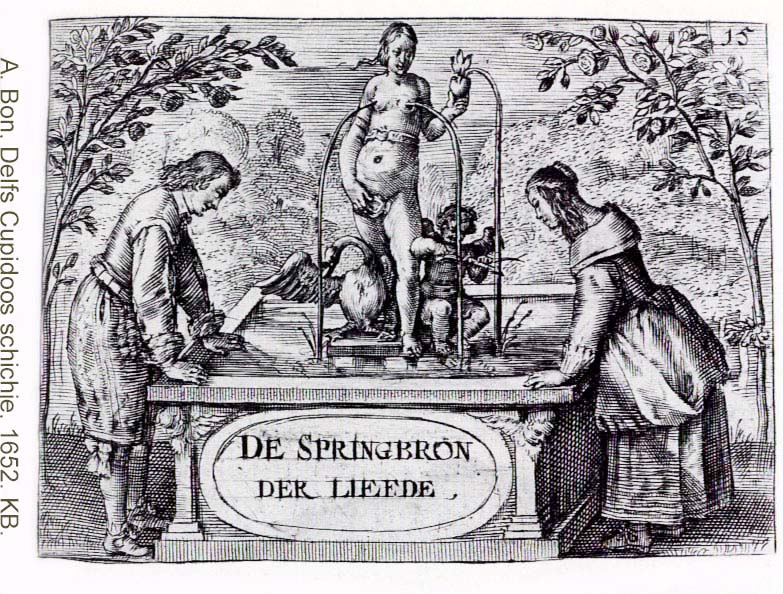 Five
books in folio size; another 25 books of all kinds, ('vyff boucken
[boeken] in folio; nog 25 [boeken] van alderhande
slach') Upstairs in the back
room. Room M.
Five
books in folio size; another 25 books of all kinds, ('vyff boucken
[boeken] in folio; nog 25 [boeken] van alderhande
slach') Upstairs in the back
room. Room M. Five
books in folio size; another 25 books of all kinds, ('vyff boucken
[boeken] in folio; nog 25 [boeken] van alderhande
slach') Upstairs in the back
room. Room M.
Five
books in folio size; another 25 books of all kinds, ('vyff boucken
[boeken] in folio; nog 25 [boeken] van alderhande
slach') Upstairs in the back
room. Room M.
One may expect Vermeer having owned books for at least three main reasons; in order to acquire useful knowledge, to acquire socially current knowledge and finally to read for relaxation.
Given the fields of interest in his paintings Vermeer's titles may have been on religion, on painting, on perspective and finally there would have been song books and sheet music.
The very precise, almost documentary way in which Vermeer paints given objects was proven in an article by Welu in which he has succeeded in pinpointing both title and edition of the open book shown in the painting Astronomer (Louvre, Paris). The book is Adriaen Metius, 'On the Investigation or Observation of the Stars', Book III, second edition, 1621 showing an engraving of the astrolabe invented by Metius himself.
But what can we say about the reading preferences of Catharina and her children? There are quite a number of reading women in Vermeer paintings!
In the seventeenth century Dutch Republic literacy was high across most social groups thanks to schools. It was probably normal to read aloud when reading a book even if one was alone. The art of silent internal reading seems to have been introduced in a later age.
In the eyes of foreign travelers and visitors the Dutch were standing out for two characteristics: their love for singing and their passion for rhyme and poetry. In that sense they were quite akin to the present day Irish ! This national enthusiasm for singing has decreased a bit over the centuries, but poetry and rhymes are still in vogue; this part of the national character has been maintained in such fields as Sinterklaas (Santa Clause) on December 5 in which surprise gifts are combined with rhymes which may be of a pleasant or critical nature.
This book case from the Oortman dolls house shown above contains a larger collection of books.
We do not know whether Vermeer owned or read the contemporary Dutch art theory books by the painters Samuel van Hoogstraten and Phlip Angel. You may now read an online full text version of the book by Philip Angel, a contemporary Leiden writer on art theory and practice, published in Leiden, 1642

Note: Photo Copyright Rijksmuseum Foundation. The Rijksmuseum has graciously assisted in this project Digital Home of Johannes Vermeer. The author was given permission to make a selection in the vast photo archive and this material has been made available by the Rijksmuseum.
This object was part of the Vermeer-inventory as listed by the clerk working for Delft notary public J. van Veen. He made this list on February 29, 1676, in the Thins/Vermeer home located on Oude Langendijk on the corner of Molenpoort. The painter Johannes Vermeer had died there at the end of December 1675. His widow Catherina and their eleven children still lived there with her mother Maria Thins.
The transcription of the 1676 inventory, now in the Delft archives, is based upon its first full publication by A.J.J.M. van Peer, "Drie collecties...", Oud Holland, 1957, pp. 98-103. My additions and explanations are added in square brackets [__]. Dutch terms have been checked against the world's largest language dictionary, the Dictionary of the Dutch Language (Woordenboek der Nederlandsche Taal, or WNT), which was begun by De Vries en Te Winkel in 1882.
Literature: José de Kruif, Liefhebbers en gewoontelezers, Leescultuur in Den Haag in de achttiende eeuw, Walburg Pers, Zutphen, 1999, p. 33, 78, 98.
James A. Welu, 'Vermeer's Astronomer: Observations on an open book,' Art Bulletin, 68, 1986, p 263-267.
Montias 1989, 179.
This page forms part of a large encyclopedic site on Vermeer and Delft. Research by Drs. Kees Kaldenbach (email). A full presentation is on view at johannesvermeer.info.
Launched December, 2002; Last update March 2, 2017.
Back to the Welcome page: click Welcome.